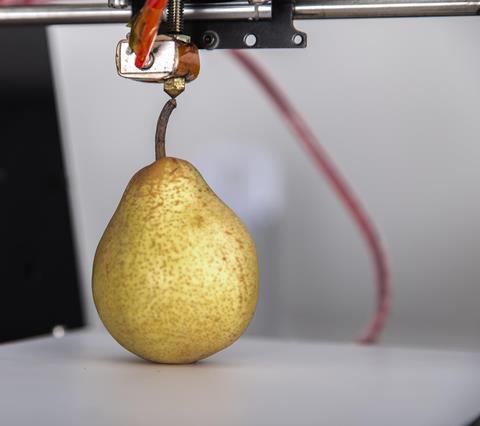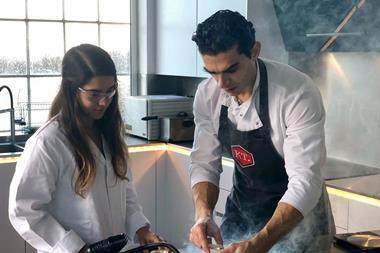Synthesised food is unlikely to sate our appetites soon
How do you like your cheese? At room temperature, grilled or extruded through a nozzle at a rate of 12mL per minute? Yes, it’s not clear if the last option will catch on. But don’t judge it too soon.

Food scientist Alan Kelly and coworkers at University College Cork, Ireland, have investigated what 3D printing does to processed cheese.1 Admittedly, it’s not obvious that there is much you can do to processed cheese (an emulsified blend of natural cheeses with other dairy products, water, vegetable fats, proteins, emulsifying salts and additives) to make it worse. But extruding it through a print head at 180°C sounds like a good way to try.
The researchers tested the mechanical properties (such as adhesiveness and springiness), microstructure and melting properties of the deposited cheese, finding that it became softer and more readily meltable once printed. This was perhaps due to disruption and subsequent partial coalescence of the fat globules. If we can systematically understand what 3D printing does to such characteristics of food, say Kelly and colleagues, then it might offer rich possibilities for ‘customised nutrition, including flexibility in geometries, textures and flavours’.
Tomorrow’s spiralisers
Psychologist Charles Spence, who runs the Crossmodal Research Laboratory at Oxford University, isn’t as optimistic about the future of 3D printing in the kitchen. ‘What new food experiences could they possibly give you?’ he asks in his new book Gastrophysics.2 Apart from creating some wacky new shapes, what will they let you do that you couldn’t do otherwise?
Today’s food printers, such as the Foodini and the Bocusini, are too expensive to become a standard kitchen gadget – they cost around $1000 (£820) each – but that figure is likely to come down. Yet if we do start to see affordable machines, says Spence, ‘my guess is that you will find all these sorry devices stored away lonely and unloved, collecting dust at the back of the cupboard, within a couple of years of the hype reaching its apex.’ In other words, they’ll be tomorrow’s bread-makers and spiralisers.
Spence is no culinary conservative. He has, for several years, advised chefs at the cutting edge of avant-garde gastronomy, such as Heston Blumenthal (there are, as you might imagine, considerable perks to that position.) His book is full of quirky innovations, such as ‘sensorial stimuli cutlery’ (bumpy spoons), acoustic engineering of the dining experience and descriptions of ‘olfactory dinner parties’ that chefs are introducing to change and enhance our appreciation of their food. You might say that Spence’s gastrophysics involves everything beyond the Maillard reaction.
Spence is not dismissing printed food on the grounds that it’s new-fangled and not ‘proper cooking’. Rather, he sees it as a decidedly niche market. The sculptures created this way by Spanish chef Paco Perez at his restaurant La Enoteca in Barcelona are reputedly amazing: renditions of famous buildings and the like (an edible Gaudí, anyone?). But how many of us could afford them, and would we feel bad about eating them? The late American chef Homaro Cantu’s experiments in 3D printing, meanwhile, owed more to his contract with Nasa to create personalised food for long-duration space missions than his career at Chicago’s renowned Moto restaurant.
Art or application
The main problem, though, is the practicality of 3D printing. Are you really going to clean out all those nozzles after you’ve impressed your friends with your latest design for customised pasta? Do you have the patience to wait for each item to be laboriously printed, layer by layer? And the current generation of 3D food printers, like the Foodini, only prepare the raw ingredients: you still then have to cook them.
Besides, as Spence’s book illustrates, there’s a lot more to our enjoyment of food than what it’s made of, or even how it is cooked. The way food looks, for example, can make a big difference to the flavour we experience. Hod Lipson, a specialist in 3D printing at Cornell University, points out that the technology could be used to make food we don’t like appear more appetising (broccoli space rockets for kids?). But equally, a sugar confection shaped like an intricate piece of Chinese pottery doesn’t look like something I’d want to eat. Lipson’s remark that ‘we have a very deep, visceral reaction to foods we don’t recognise’ cuts both ways.
There are benefits, for sure. Potentially, 3D printing might be less wasteful, although some Star trek-style food synthesiser with hundreds of cartridges containing different ingredients could be anything but. Food printers might let you tailor all the macronutrients for an optimised diet, while perhaps delivering them in a much more appetising form than a beige-coloured drink. Spence’s book makes it clear, though, that the palatability might hinge on accurate control of texture and microstructure. To what extent that can be done for pastes extruded from nozzles isn’t clear, and the Cork study seems to imply as much. I’m not going to abandoning the wooden spoon and mixing bowl just yet.
References
1 C Le Tohic et al., J. Food Eng., 2017 DOI: 10.1016/j.jfoodeng.2017.02.003
2 C Spence, Gastrophysics, 2017 London: Viking












No comments yet